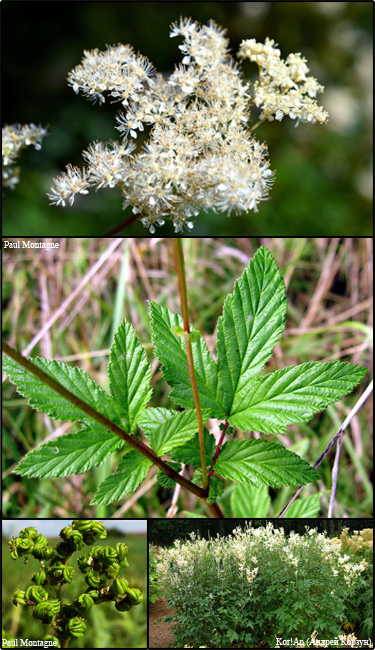Queen of the meadow (Filipendula ulmaria)
 Synonyms: Spiraea ulmaria, Ulmaria pentapetala
Synonyms: Spiraea ulmaria, Ulmaria pentapetalaCommon Names: meadowsweet, mead wort, steeplebush, bridewort
Description:
Habit: Upright, clump-forming perennial of moist habitats.
Leaves: Pinnately compound, dark green in color, with 5 pairs of leaflets, coarsely toothed and deeply veined. Leaves are hairy and whitish on the undersides. Leaflets occur on stem between leaves.
Stems: Woody at the base and typically grows 3-4 feet tall.
Flowers: Showy and fragrant. Branching panicles or cymes (erect clusters) of small, white-cream colored flowers. Individual flowers have 5 petals and numerous stamens, giving the flowers a "fuzzy" appearance.
Fruit and seeds: Spherical, irregular and twisting achene. Resembles cultivated garden Nasturtium seeds.
Habitat: Native to western Asia and Europe. Found in wetlands, bogs, fens, marshes, floodplain forests, moist meadows, freshwater estuaries, wet rock ledges and roadside ditches.
Reproduction: By seed or vegetative by rhizomes.
Similar species: Queen of the prairie (Filipendula rubra) is a common ornamental plant native to southeastern United States. Leaves are palmately compound and flowers are pink in color.
Monitoring and rapid response: Dig up entire plant, removing entire root system. Cut or mow flowering tops prior to maturation and seed-set. Use of aquatically-approved herbicides may be effective. Credits: The information provided in this factsheet was gathered from the Wisconsin Department of Natural Resources.
Individual species images that appear with a number in a black box are courtesy of the Bugwood.org network (http://www.invasive.org).Individual photo author credits may not be included due to the small display size of the images and subsequent difficulty of reading the provided text. All other images appear courtesy of Google (http://images.google.com).
